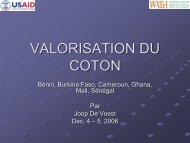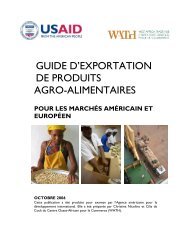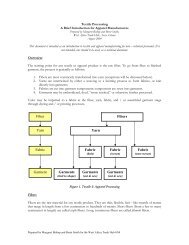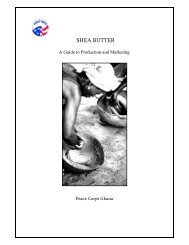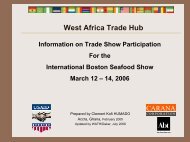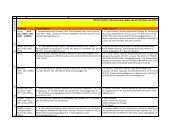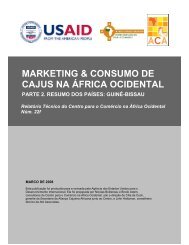A Value Chain Analysis of the Cashew Sector - AGOA Export Toolkit
A Value Chain Analysis of the Cashew Sector - AGOA Export Toolkit
A Value Chain Analysis of the Cashew Sector - AGOA Export Toolkit
Create successful ePaper yourself
Turn your PDF publications into a flip-book with our unique Google optimized e-Paper software.
1.3 Major Data on <strong>Cashew</strong> Production<br />
and Processing in Ghana<br />
In 2008, 61,590 t <strong>of</strong> raw cashew nuts valued US$ 45.37 million<br />
were exported for processing, mainly to India, while annual<br />
local production was estimated to be 26,454 t. Th ese numbers<br />
indicate cross border trading <strong>of</strong> raw cashew nuts between Ghana<br />
and neighbouring countries, especially Côte d’Ivoire. In 2008,<br />
RCN exports contributed to 6.1% <strong>of</strong> GDP and to 18.2% <strong>of</strong> agricultural<br />
GDP (computed according to data available from <strong>the</strong><br />
Ghana Shippers’ Council and <strong>the</strong> Ghana Statistical Service). It has<br />
been estimated that <strong>the</strong> cashew sub-sector can contribute to<br />
pro-poor economic growth by generating over 200,000 permanent<br />
and seasonal jobs, particularly for farm labourers and intermediaries<br />
(<strong>Cashew</strong> Development Project, 2008). Fur<strong>the</strong>r-<br />
Table 1.1 Importance <strong>of</strong> <strong>the</strong> <strong>Cashew</strong> <strong>Value</strong> <strong>Chain</strong> for <strong>the</strong> National Economy<br />
Human Development Index<br />
(global ranking)<br />
GDP<br />
152 (out <strong>of</strong> 177)<br />
ÿ US$ 744.32 million<br />
ÿ O<strong>the</strong>r sources provide<br />
signifi cantly different<br />
fi gures for nominal<br />
GDP in 2008:<br />
ÿ CIA: US$ 16.12 billion<br />
ÿ IMF: US$ 16.65 billion<br />
ÿ AfDB: US$ 14.7 billion<br />
<strong>Cashew</strong> Source <strong>of</strong> Information<br />
6.1% <strong>of</strong> national GDP*<br />
Agricultural GDP US$ 250 million*** 18.2 % <strong>of</strong> agricultural GDP*<br />
Agricultural GDP’s share<br />
<strong>of</strong> national GDP<br />
Raw cashew nuts produced<br />
in 2008<br />
Raw cashew nuts exported<br />
in 2008<br />
Raw cashew nuts produced<br />
worldwide in 2007<br />
Agricultural area cultivated<br />
33.6%<br />
26,454 t**<br />
61,590 t**<br />
Total population in 2000 18,912,079<br />
Total population in 2009<br />
(estimated)<br />
Poverty incidence<br />
in 2005/2006 (%)<br />
Equals 1.3% <strong>of</strong> <strong>the</strong> total global<br />
production estimated for 2008<br />
Human Development<br />
Report 2009 (UNDP)<br />
Ghana Statistical Service (2008)<br />
Ghana Shippers’ Council (2008)<br />
2.1 million t (2008 estimate - 2 million t) Red River Foods, Inc. (2008)<br />
13.6 million ha a (i.e. approx.<br />
30% <strong>of</strong> total land area b -<br />
this fi gure seems to be<br />
ra<strong>the</strong>r optimistic; o<strong>the</strong>r<br />
sources indicate about 16%<br />
is used as arable land and<br />
10% for permanent crops)<br />
23,832,495<br />
28.5%, <strong>of</strong> which 10.8% is<br />
urban-related and 39.2%<br />
is rural-related<br />
more, RCN marketing, distribution and processing <strong>of</strong>f er more<br />
than 5,000 permanent and seasonal jobs annually in <strong>the</strong> cashew<br />
industry as it now stands (CDP, 2009a).<br />
Th e Ghana <strong>Cashew</strong> Industry Study conducted by MOFA in<br />
1998 estimated that Ghana has enough land to develop new<br />
plantations <strong>of</strong> about 60,000 ha by 2008 and up to 100,000 ha<br />
by 2020. However, strong doubts exist about <strong>the</strong> credibility <strong>of</strong><br />
<strong>the</strong>se fi gures due to generally lacking resources (such as land and<br />
water), <strong>the</strong> competition for resources arising from <strong>the</strong> production<br />
<strong>of</strong> o<strong>the</strong>r food and cash crops, and <strong>the</strong> possible negative impact<br />
on (agro-) biodiversity. Tables 1.1-1.6 that follow summarise<br />
major data on cashew production and processing in Ghana,<br />
and place <strong>the</strong> cashew sector in <strong>the</strong> broader context <strong>of</strong> <strong>the</strong><br />
country’s economy.<br />
7 % <strong>of</strong> area cultivated with<br />
tree crops, including cashew<br />
In 2000, 70% <strong>of</strong> <strong>the</strong> population<br />
was engaged in agriculture, <strong>of</strong><br />
which 0.53% (i.e. around<br />
70,000 people) were involved<br />
in cashew production<br />
a AfDB (2006): Appraisal Report<br />
– Afram Plains Agricultural<br />
Development Project<br />
b WTO Trade Policy Review<br />
(2008)<br />
Ghana Statistical Service (2002)<br />
CIA World Fact Book and AfDB<br />
(2009)<br />
Ghana Statistical Service (2007)<br />
* Figures refer to <strong>the</strong> total volume <strong>of</strong> RCN exported.<br />
** The difference between local production and exports is mainly explained by smuggling from neighbouring countries.<br />
*** This fi gure changes according to <strong>the</strong> level <strong>of</strong> GDP specifi ed.<br />
13



